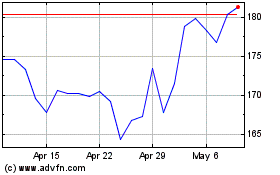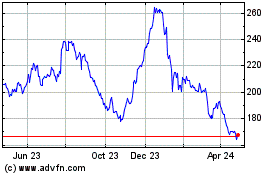Boeing Secures Billions In Loans -- WSJ
February 01 2020 - 3:02AM
Dow Jones News
By Doug Cameron
This article is being republished as part of our daily
reproduction of WSJ.com articles that also appeared in the U.S.
print edition of The Wall Street Journal (February 1, 2020).
Boeing Co. has lined up at least $12 billion in bank loans and
may tap the commercial paper market to counter the cash drain from
the 737 MAX crisis.
The aerospace giant said in a regulatory filing that it expects
to close a two-year loan in February after securing bank
commitments, and has the option to increase the facility if it is
oversubscribed.
The planned loan would help fund compensation for buyers of the
grounded jet and support Boeing suppliers after the company halted
production of the MAX. The added funds would also pay for Boeing's
stock dividend, which it opted to keep at existing levels this
year.
The aircraft maker ended 2019 with $10 billion in cash, a level
of liquidity that Boeing has maintained in recent years, tapping
the bond market twice last year and doubling the size of its
revolving loan facility.
"We believe our ability to access external capital resources
should be sufficient to satisfy existing short-term and long-term
commitments and plans," the company said in the filing.
Boeing's planning assumes it will secure regulatory approval for
the MAX to re-enter commercial service by midyear, with assembly of
the planes resuming about two months prior.
If the timetable holds, suppliers estimate Boeing will be able
to produce about 200 new jets this year.
Boeing said it will take about a year to hand over the 400
planes that are built and in storage, though some airlines and
leasing companies view that as optimistic. Another 380 planes that
had been flying before the grounding nearly a year ago will have to
be restored to service condition.
While Boeing's long-term credit ratings were downgraded by
agencies over the past few weeks as MAX costs spiraled, short-term
ratings for the company were largely left unchanged, maintaining
its access to the bank market.
The planned new loan is a so-called delayed draw facility, which
gives Boeing more flexibility than a bond issue in terms of the
level of borrowing and repayment.
Charges and additional costs linked to the MAX, grounded by
regulators since March following two fatal crashes, now top $19
billion.
While Boeing has collected a $500 million insurance payout, it
said in the filing that there was no guarantee that other policies
would entirely cover any cost from the multiple lawsuits it faces
from families of the 346 who died in the two crashes, as well as
expenses tied to legal action from some customers.
Boeing also faces a $4.2 billion payment to take a majority
stake in the jetliner arm of Brazil's Embraer SA, a transaction it
aims to complete by midyear. One of last year's bond issues was
earmarked for the deal, which has yet to clear a regulatory review
by the European Union.
There are other potential bills.
The company said it may have to finance some new jetliner
deliveries this year or provide temporary funding to airlines,
though it remained bullish on alternative external sources.
Boeing said in the filing that such financing commitments --
where it is effectively paying for jets on behalf of customers --
fell to $419 million last year from $601 million in 2018, though
aircraft deliveries more than halved in the same period.
It has also earmarked $4 billion for 2020 and 2021 to cover
unexpected costs relating to MAX production, including support for
suppliers.
The company disclosed the scale of two non-MAX charges,
including $148 million linked to higher costs on the KC-46A
military refueling tanker. It also took a $293 million to write off
goodwill attached to its Aviall services business.
Write to Doug Cameron at doug.cameron@wsj.com
(END) Dow Jones Newswires
February 01, 2020 02:47 ET (07:47 GMT)
Copyright (c) 2020 Dow Jones & Company, Inc.
Boeing (NYSE:BA)
Historical Stock Chart
From Mar 2024 to Apr 2024

Boeing (NYSE:BA)
Historical Stock Chart
From Apr 2023 to Apr 2024
